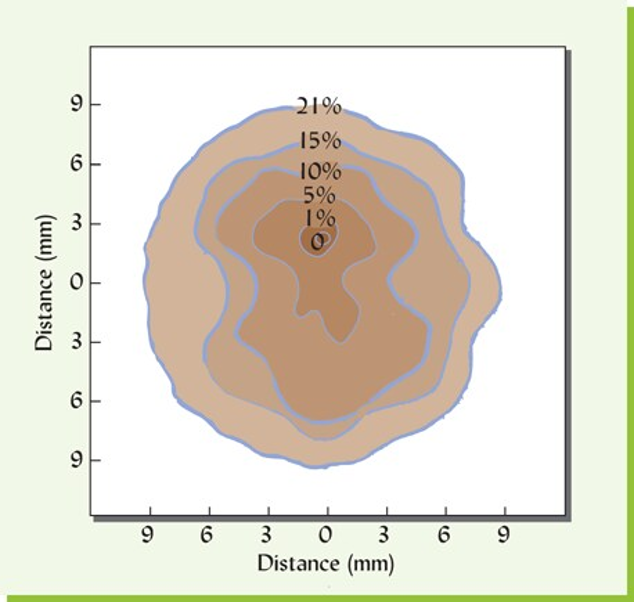Aggregation
Soil aggregates form when you have active biology. All this infintesimal biota,” says Peter Donovan, yields “sticky colloidal slimes from all the kingdoms of life” – strings and glues that hold the particles together. Many biotic glues are not water soluble, which allows them to remain in place when water infiltrates are hits the soil surface. Glomalin forms a “lattice-like waxy coating” around soil aggregates that protect it. Glomalin contains 30-40% C. Soil without aggregates is like flour. A little water is absorbed but the pore space is quickly filled and water can no longer infiltrate. Well-aggregated soil is like leavened bread, which is created with fungal yeast. Unleavened bread does not have the fungal component. Leavened bread can infiltrate, hold and store more air and water than flour or unleavened bread. It’s no wonder that aggregation is referred to as “crumb structure”. (Water in Plain Sight, pg. 49/50)
Extended rainfall simulator with Ray Archuleta (https://www.youtube.com/watch?v=Ovy1DCxN340)
Bacterial biofilm production (https://www.sciencedirect.com/science/article/pii/S0160412019320392)
Their soils have become more like a spongy matrix, able to withstand extreme weather and compression from five ton tractors and four-legged animals.
Natural aggregate cycling (https://www.ilsoyadvisor.com/aggregates-are-essential-healthy-soil/)
“Macroaggregates (diameter > 0.25 mm) help the soil surface to resist erosive forces, but their contribution to soil surface stability changes with time because macroaggregate formation and disintegration is a dynamic process.” (https://www.sciencedirect.com/science/article/abs/pii/S0016706121001762)
“Macroaggregates normally contain more labile substrates predominantly derived from plant residues (Bronick and Lal, 2005), and harbor higher amounts of fungal biomass than microaggregates (MAs, Rillig and Mummey, 2006).
In contrast, MAs are characterized by the highest concentration of
stable organic carbon, and more importantly, they provide a protective
microenvironment for microbial growth (Six et al., 2000).
The relative small pore sizes make MAs inaccessible to large-sized
bacterial-feeding nematodes (typically 30–90 μm in diameter; Quénéhervé and Chotte, 1996). Thus, it is crucial to understand the predator–prey interactions at the aggregate level (Ettema and Wardle, 2002).” (https://www.nature.com/articles/ismej2017120)



It’s like my mother always says, “When you do the right things for the right reasons, things always work out.” We may never know the exact reasons for everything that happens on our farms and ranches, but it’s abundantly clear that nature operates in a way that is efficient and life-giving. The more we follow the script nature has written for us, the more health and balance we will observe on our operations, especially when it comes to water. The next time someone asks you how much rain you got, I hope you think about responding with “All of it”. Think about water yield. How much plant material, lbs per acre am I producing with each inch of water I get? Whether you are arable or livestock… Dr. John Liu’s work regreening the Chinese Loess Plateau is truly inspirational for anyone that has not seen it. This short video documents the dramatic transformation of the landscape from desert conditions in the mid-90’s to verdant hills by the 2010’s.
We create our own droughts, floods and in some cases, our own rain.
Spongy soil is capable of resisting compaction by returning to its
original shape after being run over by a five ton tractor or hundreds of
thousands of pounds of livestock. Think about the implications that has
on water.
Many practical issues that depend on your specific context, such as making sure cover crops leave enough moisture for cash crops, etc.Be smart with cover crops because they are living organisms and do require water, but time and again research and anecdotal evidence shows a chronic improvement in water cycling.
Living organisms, including us, release water back into the environment through the exhalation of water vapor produced during energy production, through waste, such as urine and manure, and many organisms release water as a cooling mechanism, such as with human sweat and plant transpiration.
“In turning to technology to solve water problems, so often we are merely relieving the symptoms of an impaired water cycle without acknowledging or addressing the cause. Restoring the water cycle needs to be done with biology; our success will turn on how we manage the land and water of a living system.” (WIPS pg 60)
This is huge for livestock owners looking to graze more days of the year
with wet seasons in climates that don’t freeze, such as the American
South and the UK.